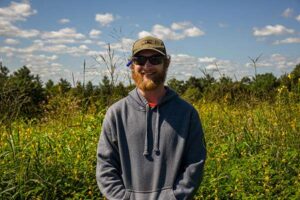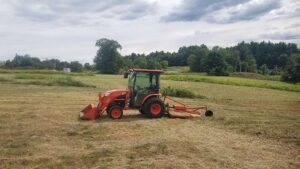Q&A with Robert Graham, New England Botanic Garden Staff
August 2023
One summer spectacle at the Garden impresses guests even before they enter the Visitors Center. Acres of meadows bloom from June all the way through the fall. Though meadows may seem low maintenance, these unique and beautiful spaces require careful management. Recently, the Garden’s Land Steward Robert Graham shared some of his meadow management strategies in a member-exclusive article published by the Ecological Landscape Alliance (ELA). ELA promotes sustainable approaches to landscape design, construction, and management, and its membership includes landscape professionals that work across the country.
We caught up with Robert to learn more about the Garden’s meadows and discuss the growing interest many are taking in cultivating meadows both for their beauty and ecological value.
NEBG: First, what are meadows and why are they important?
Robert Graham: Meadows are an important natural feature of the New England landscape. They represent a stage in secondary successional habitat development, emerging after landscape disturbances like fire or flooding. Meadows provide valuable habitat for many different native plants and animals, and they were much more common historically than they are today. This is due to a number of factors from development to invasive plants and fire suppression. At the Garden, we maintain more than 20 acres of early successional meadow habitat in a variety of forms, from dry, highly disturbed parking lot island meadows where vetch (Vicia spp.) and garden bird’s-foot trefoil (Lotus corniculatus) aggressively try to take over newly established seed, to wet meadows full of willow (Salix spp.) and Joe-Pye weed (Eutrochium spp.). We use ecological land management practices to promote native plants and demonstrate to our visitors what a native wildflower meadow can look like with proper management in hopes that they might take what they’ve seen here and create similar areas at their home gardens, businesses, and other locations.
It’s good to see more and more public interest in meadows. Right now, we’re facing a crisis of biodiversity loss and habitat destruction is one of the primary drivers, so creating and maintaining habitats of native plants wherever we can, as entomologist Douglas Tallamy advocates for in his Homegrown National Parks movement, is really important.
NEBG: What kind of plants can be found in the different meadow spaces at the Garden?
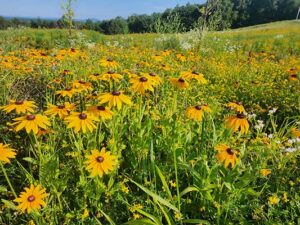
Meadow three years post-construction pictured in late June with a heavy presence of black-eyed coneflower (Rudbeckia hirta) growing over naturalized species clover (Trifolium spp.) and patches of bird’s-foot trefoil (Lotus corniculatus).
Robert Graham: Many different meadows are spread throughout the property, some of the biggest ones being near the parking lots and across from the apple orchard. There are also many small meadows scattered along the edges of gardens, paths, and woodlands.
Some of the more familiar species seen in the meadows are plants like common milkweed (Asclepias syriaca), black-eyed coneflower (Rudbeckia hirta), and lance-leaved tickseed (Coreopsis lanceolata). These plants are readily available at nurseries as native garden ornamentals, and are tough, hardy plants. Currently blooming in the meadows in late August we have multiple goldenrods (Solidago spp.), Joe-Pye weed (Euthrochium spp.), false sunflower (Heliopsis helianthoides), partridge pea (Chamaecrista fasciculata), and showy tick-trefoil (Desmodium canadense).
NEBG: How do you manage the Garden’s meadows?
Robert Graham: All meadows need disturbance. For the last few hundred years, the primary disturbance type at the Garden property was pasture grazing of livestock. When that stopped in 1986 after the property was transitioned from farm to garden, a new type of disturbance — mowing — was needed to keep intermediate succession species like trees and shrubs from establishing in the newly unmaintained areas.
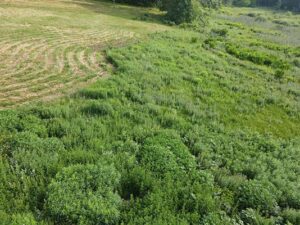
Selective spring mowing in the Garden’s “Daffodil Field Meadow.” The patches intentionally left are primarily goldenrod and blackberry.
For many years, fall was considered the best season to mow. With one late season cut, meadow maintenance is finished for the year, and the meadow establishes itself on its own starting in spring. Single cut fall mowing is an effective way to keep invasive plants and woody materials from fully establishing. Plus, as the ground is typically drier in fall, the risk of heavy mowers causing soil compaction is low. But despite these benefits, spring is starting to come into favor as the preferred time of year for large-scale meadow mowing because it’s the best way to protect habitat health. Leaving meadow plants standing through fall provides overwintering pollinator habitat as well as food and shelter for birds and other wildlife.
In our drier, upland meadows, I mow multiple times throughout the season to knock back cool season grasses and invasive species and give more room for warm season grasses and native wildflowers to thrive. We have a high water table here and a lot of wet meadows, so in some areas, fall mowing is the only option. To protect wildlife and plant habitat, I mow these meadows as high as reasonably possible to leave stems that many of our region’s native bees use for nest sites. I also leave wildlife islands, big areas of untouched meadow. I preserve areas where milkweed seed has not fully ripened and areas where there is no risk of invasive plants standing for winter. This creates a protected winter habitat for plants, pollinators, native mammals, and winter birds.
NEBG: What advice would you give to readers interested in establishing their own meadow spaces?
Robert Graham: Meadow installations, big or small, can be a huge undertaking. While long-term, well-established meadows fit the bill for the “low maintenance garden that we all hope for, it takes a lot of work to get to that point. Small-scale meadows under one acre are the most easily obtainable here in central Massachusetts. From commercial lots to home gardens, spaces of this size can provide early successional habitat. One method we have used at the Garden for small meadow installations in areas that are mown grass is to remove the sod layer with a sod cutter to expose bare soil. We then rake out the newly exposed soil and install native wildflower seed by hand. Salt marsh hay, a weed free hay, is then spread over the new seed material to protect it from bird and animal foraging. This also helps to prevent seeds from moving in rain and wind. For immediate results, removing the sod layer is hugely beneficial because it allows the seed to germinate with little to no competition. The problem with this method is that it disturbs the soil which can lead to erosion and the loss of beneficial microorganisms. Disturbed soils are also an easy target for invasive seed recruitment. But for most homeowners looking to install a small meadow, I’d recommend smothering the sod or other undesired weed growth with cardboard instead of ripping it up altogether. This method is quick and less involved than removing than sod layer, and it better protects the soil. For those interested in learning more, Leslie Duthie, a horticulturist who also volunteers at the Garden, writes about this process and her own experiences transforming lawn into meadow in an article with the Ecological Landscape Alliance called “Lawn Murder.”
Interested in learning even more?
The Garden partners with ELA to sponsor special educational opportunities including the Season’s End Summit coming up October 26. This year’s summit, “Disturbance on the Landscape,” will feature presentations on topics including using fire as an ecosystem management tool, creating low maintenance native landscapes, soil disturbance, and habitat restoration for wildlife conservation. The summit is a hybrid in-person and virtual event open to the public, so we hope to see lots of people there.
Robert Graham is the Land Steward at New England Botanic Garden at Tower Hill located in Boylston, MA. He has been with the organization since 2017 and is responsible for overseeing all formal groundskeeping as well as management of all naturalistic areas including meadows, woodlands, and wetlands. Robert earned his BS in Biology from Worcester State University where he focused on conservation biology and GIS. His professional interests include early successional habitats, native plant ecology, and sustainable land management.
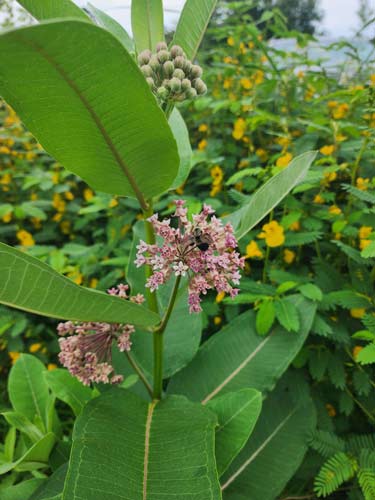
Common milkweed blooming with partridge pea in the background
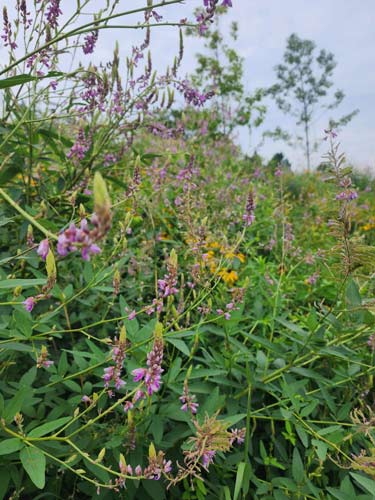
Showy tick trefoil
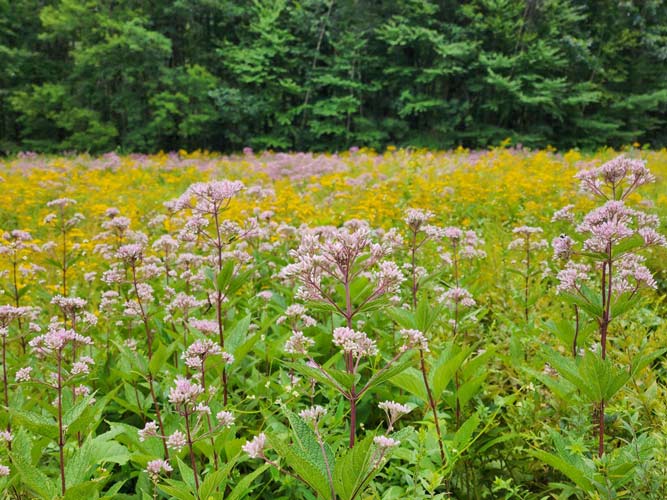
Joe-Pye weed pictured with goldenrod behind
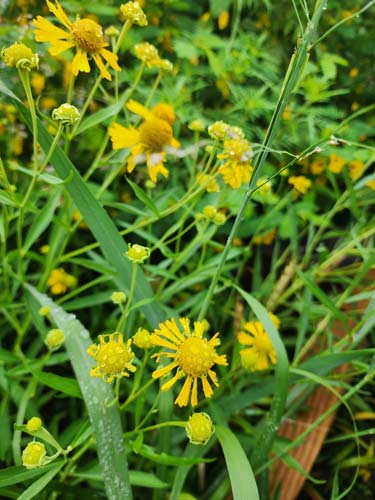
Common sneezeweed
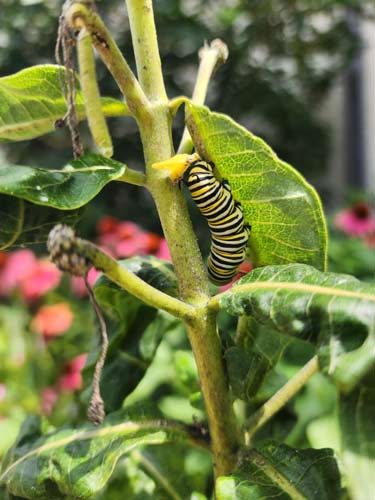
Monarch caterpillar on common milkweed growing alongside a path
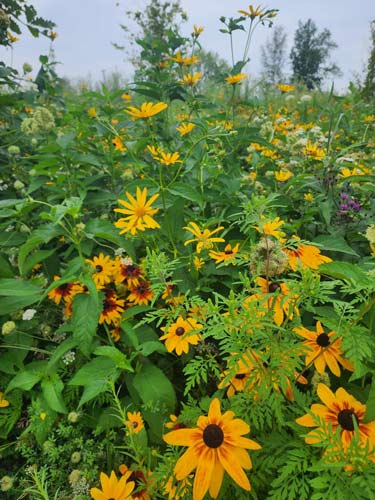
Black-eyed coneflower and false sunflowers in bloom
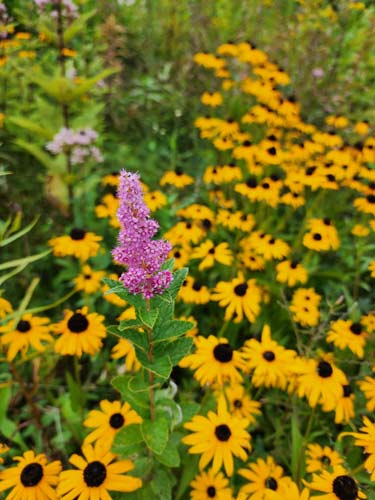
Steeplebush blooming among black-eyed coneflower
Botanical names of plants pictured above in order of appearance:
Common milkweed (Asclepias syriaca) with partridge pea (Chamaecrista fasciculata), showy tick trefoil (Desmodium canadense), Joy-Pye weed (Eutrochium purpureum) pictured with goldenrod (Solidago spp.) behind, common sneezeweed (Helenium autumnale), common milkweed (Asclepias syriaca), black-eyed coneflower (Rudbeckia hirta) pictured with false sunflower (Heliopsis helianthoides), steeplebush (Spiraea tomentosa) among black-eyed coneflower (Rudbeckia hirta).

